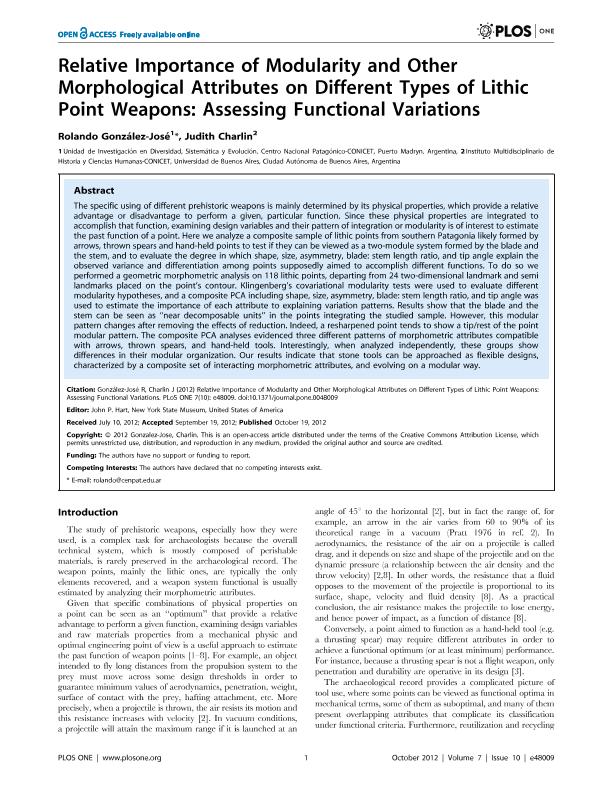Mostrar el registro sencillo del ítem
dc.contributor.author
González José, Rolando

dc.contributor.author
Charlin, Judith Emilce

dc.date.available
2018-04-18T19:23:54Z
dc.date.issued
2012-10
dc.identifier.citation
González José, Rolando; Charlin, Judith Emilce; Relative importance of modularity and other morphological attributes on different types of lithic point weapons: assessing functional variations; Public Library of Science; Plos One; 7; 10; 10-2012; 1-9; e48009
dc.identifier.issn
1932-6203
dc.identifier.uri
http://hdl.handle.net/11336/42537
dc.description.abstract
The specific using of different prehistoric weapons is mainly determined by its physical properties, which provide a relative advantage or disadvantage to perform a given, particular function. Since these physical properties are integrated to accomplish that function, examining design variables and their pattern of integration or modularity is of interest to estimate the past function of a point. Here we analyze a composite sample of lithic points from southern Patagonia likely formed by arrows, thrown spears and hand-held points to test if they can be viewed as a two-module system formed by the blade and the stem, and to evaluate the degree in which shape, size, asymmetry, blade: stem length ratio, and tip angle explain the observed variance and differentiation among points supposedly aimed to accomplish different functions. To do so we performed a geometric morphometric analysis on 118 lithic points, departing from 24 two-dimensional landmark and semi landmarks placed on the point´s contour. Klingenberg´s covariational modularity tests were used to evaluate different modularity hypotheses, and a composite PCA including shape, size, asymmetry, blade: stem length ratio, and tip angle was used to estimate the importance of each attribute to explaining variation patterns. Results show that the blade and the stem can be seen as ?near decomposable units? in the points integrating the studied sample. However, this modular pattern changes after removing the effects of reduction. Indeed, a resharpened point tends to show a tip/rest of the point modular pattern. The composite PCA analyses evidenced three different patterns of morphometric attributes compatible with arrows, thrown spears, and hand-held tools. Interestingly, when analyzed independently, these groups show differences in their modular organization. Our results indicate that stone tools can be approached as flexible designs, characterized by a composite set of interacting morphometric attributes, and evolving on a modular way.
dc.format
application/pdf
dc.language.iso
eng
dc.publisher
Public Library of Science

dc.rights
info:eu-repo/semantics/openAccess
dc.rights.uri
https://creativecommons.org/licenses/by-nc-sa/2.5/ar/
dc.subject
Archaeology
dc.subject
Modularity
dc.subject
Integration
dc.subject
Lithic Points
dc.subject.classification
Historia

dc.subject.classification
Historia y Arqueología

dc.subject.classification
HUMANIDADES

dc.title
Relative importance of modularity and other morphological attributes on different types of lithic point weapons: assessing functional variations
dc.type
info:eu-repo/semantics/article
dc.type
info:ar-repo/semantics/artículo
dc.type
info:eu-repo/semantics/publishedVersion
dc.date.updated
2018-04-16T14:45:25Z
dc.journal.volume
7
dc.journal.number
10
dc.journal.pagination
1-9; e48009
dc.journal.pais
Estados Unidos

dc.journal.ciudad
San Francisco
dc.description.fil
Fil: González José, Rolando. Consejo Nacional de Investigaciones Científicas y Técnicas. Centro Científico Tecnológico Conicet - Centro Nacional Patagónico; Argentina
dc.description.fil
Fil: Charlin, Judith Emilce. Consejo Nacional de Investigaciones Científicas y Técnicas. Oficina de Coordinación Administrativa Saavedra 15. Instituto Multidisciplinario de Historia y Ciencias Humanas; Argentina
dc.journal.title
Plos One

dc.relation.alternativeid
info:eu-repo/semantics/altIdentifier/url/https://www.ncbi.nlm.nih.gov/pmc/articles/PMC3477140/
dc.relation.alternativeid
info:eu-repo/semantics/altIdentifier/url/http://journals.plos.org/plosone/article?id=10.1371/journal.pone.0048009
dc.relation.alternativeid
info:eu-repo/semantics/altIdentifier/doi/http://dx.doi.org/10.1371/journal.pone.0048009
Archivos asociados
